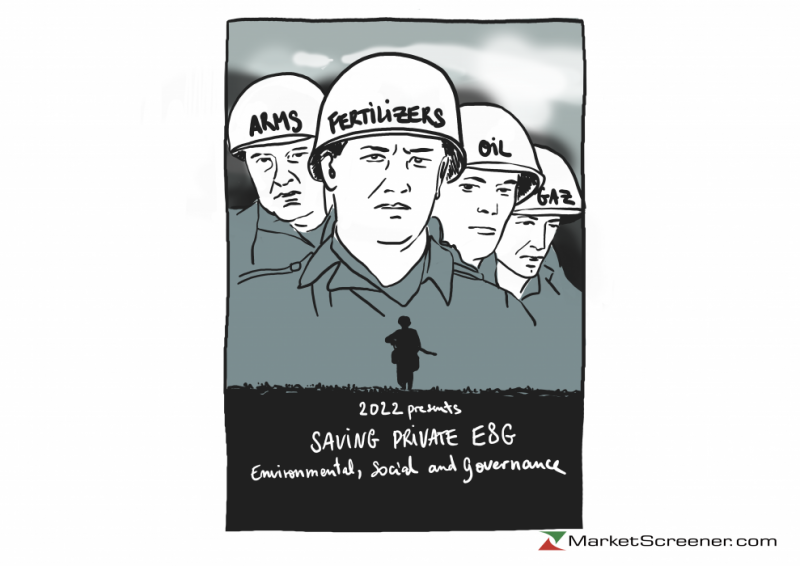|
|
| This week's gainers and losers |
|
|
| Commodities |
While oil prices have given up some ground this week, volatility has not abated. The last few sessions have remained turbulent, with often brutal daily movements, both up and down. Operators are closely watching the talks between Russian and Ukrainian delegations, looking for the slightest sign of appeasement that would be synonymous with an easing of prices. At the price level, prices are holding above the USD 100 threshold for the two global references, Brent (USD 107) and WTI (USD 104). Supply remains tight, prompting the International Energy Agency (IEA) to urge OPEC countries to significantly increase production at their next monthly summit. For the time being, the cartel remains unmoved by this type of demand and is sticking to its roadmap of gradually lifting production quotas. This is a blow to gold buyers, who see the price of the golden metal moving away from the USD 2,000 per ounce mark, despite rising inflation and uncertainty created by the war in Europe. Investors have regained some risk appetite, as evidenced by the changes in the world's major stock indices. This is at the expense of gold, but also of the precious metals segment in general, as silver, platinum and palladium recorded a week of declines. In industrial metals, it is also time to relax, a more than legitimate pause after the rally achieved by the entire segment. Copper is stabilizing around USD 10,165, tin is soaring to USD 41,8550 while aluminum is trading at USD 3288 per ton. On the other hand, the LME is still struggling to get nickel trading back on track, with the price quickly reaching the maximum daily limit imposed by the LME, set at +/-5%. In soft commodities, wheat and corn prices declined this week in Chicago to 1075 and 754 cents per bushel respectively. |
|
| Macroeconomics |
|
The U.S. central bank acted on Wednesday to launch a new monetary cycle, with its first rate hike since the end of 2018. As expected, the hike was for the union minimum, a quarter point. The range is no longer 0 to 0.25 but 0.25 to 0.50. Raising rates reduces the money supply in circulation and, theoretically, calms inflation. Of course, the transmission belt is neither instantaneous nor automatic. The rate hikes will continue throughout the year, to extinguish the overheating of prices. The Fed hopes to control the economic momentum, but not break it. This is a balancing act given the external shocks that are underway and, admittedly, the central bank's late awakening. The good news is that the market was prepared for such a speech. U.S. stocks hesitated a bit at the time of the announcement, before choosing to rise. Strangely enough, the dollar is no longer able to take advantage of this, as it remains close to the 1.10 USD for 1 EUR zone. The greenback, on the other hand, continued to rise against the yen, to JPY 119.34. Confirmation of the new cycle of monetary tightening reinforced the rise in the yield on 10-year US debt to around 2.15%. In Europe, the Bund is at 0.35%, the OAT at 0.81% and the Gilt at 1.5%. Nervousness in the cryptocurrency market has come down a notch this week. Despite a still very tense geopolitical environment, the market leader, bitcoin, has now been hovering around $40,000 for many days. It must be said that in this burning political and economic context, the appetite of investors for digital assets, considered risky assets, may still be suspended for some time. A situation that puts the nerves of crypto-investors, who are used to large amplitudes on the price of the crypto-currency, to a severe test. Next week, focus on confidence surveys, with the Flash PMI indicators of major economies for March announced on Thursday. On Friday, it will be the Ifo index of German business sentiment. The figures are likely to be considerably downgraded by the war in Ukraine. There will also be speeches by Jerome Powell (Monday, Wednesday) and February US durable goods orders (Thursday again). |
|
|
| Things to read this week | ||||
|
|
*The weekly movements of indexes and stocks displayed on the dashboard are related to the period ranging from the open on Monday to the sending time of this newsletter on Friday. The weekly movements of commodities, precious metals and currencies displayed on the dashboard are related to a 7-day rolling period from Friday to Friday, until the sending time of this newsletter. These assets continue to quote on weekends. |

 By
By 
































